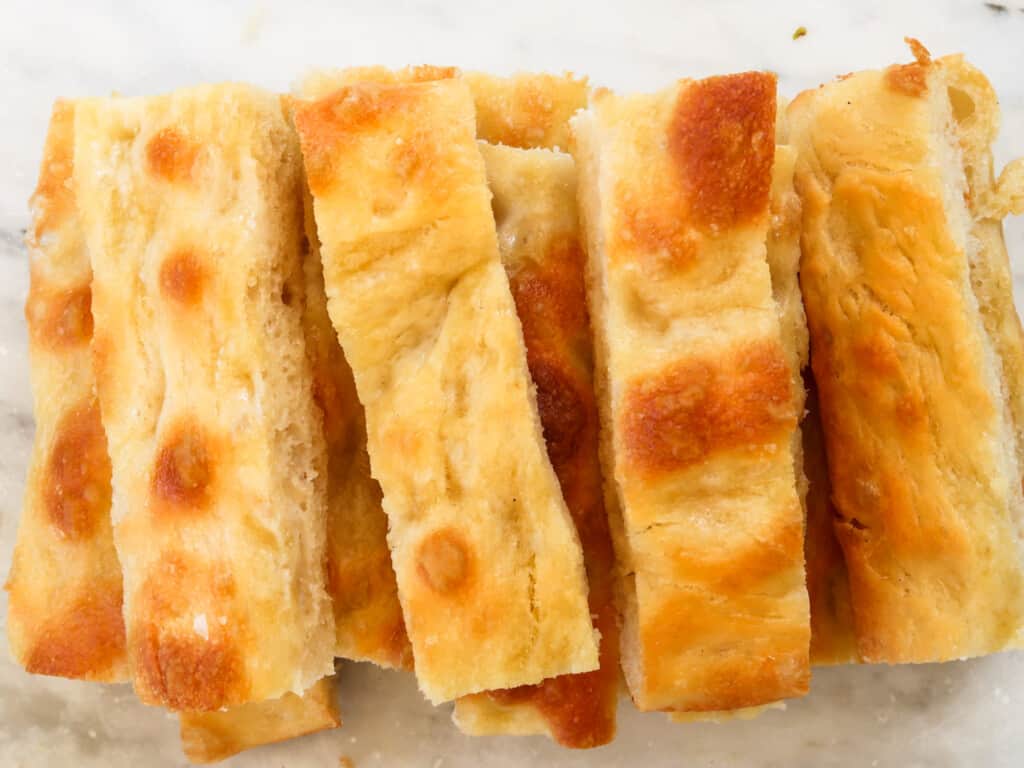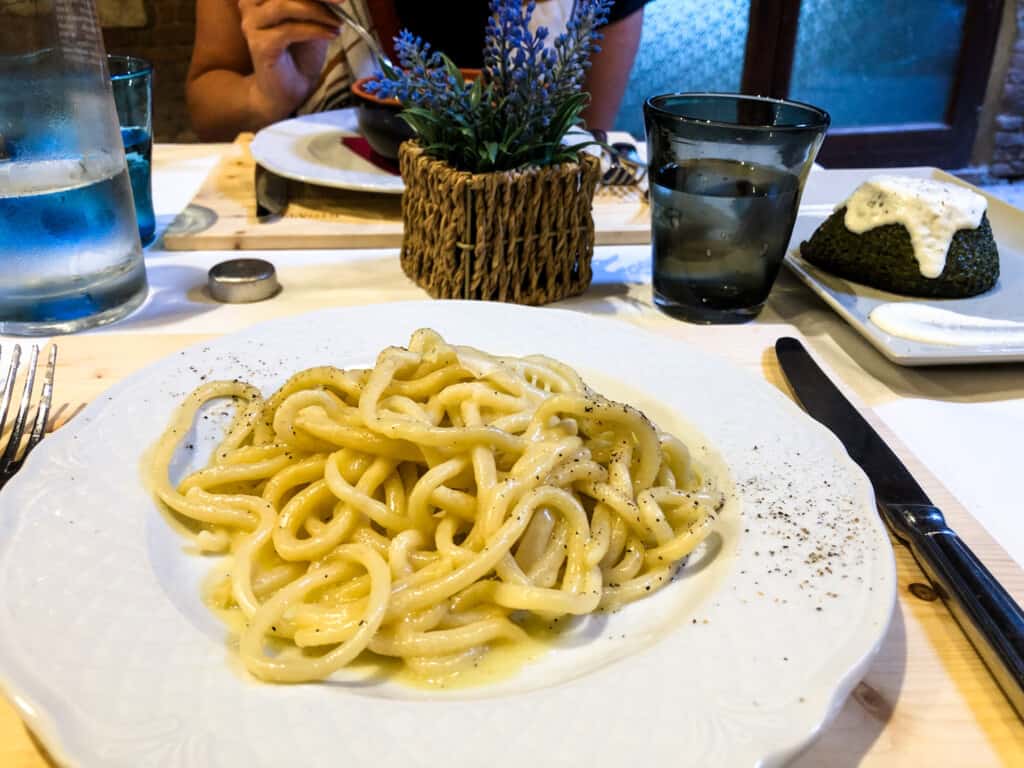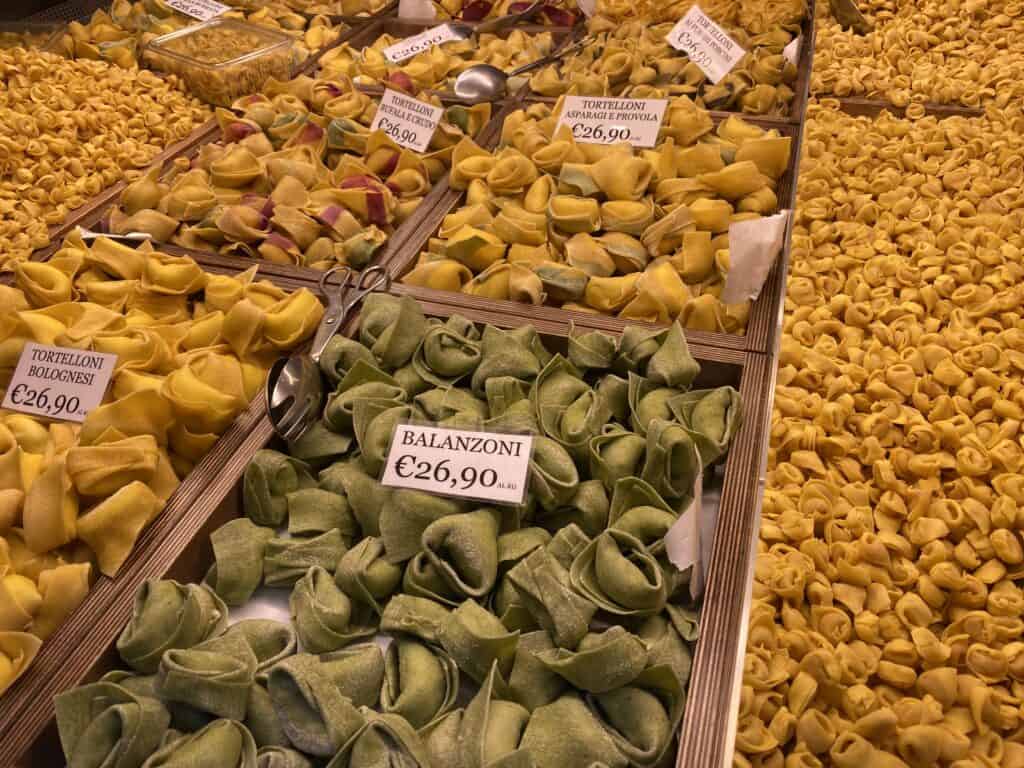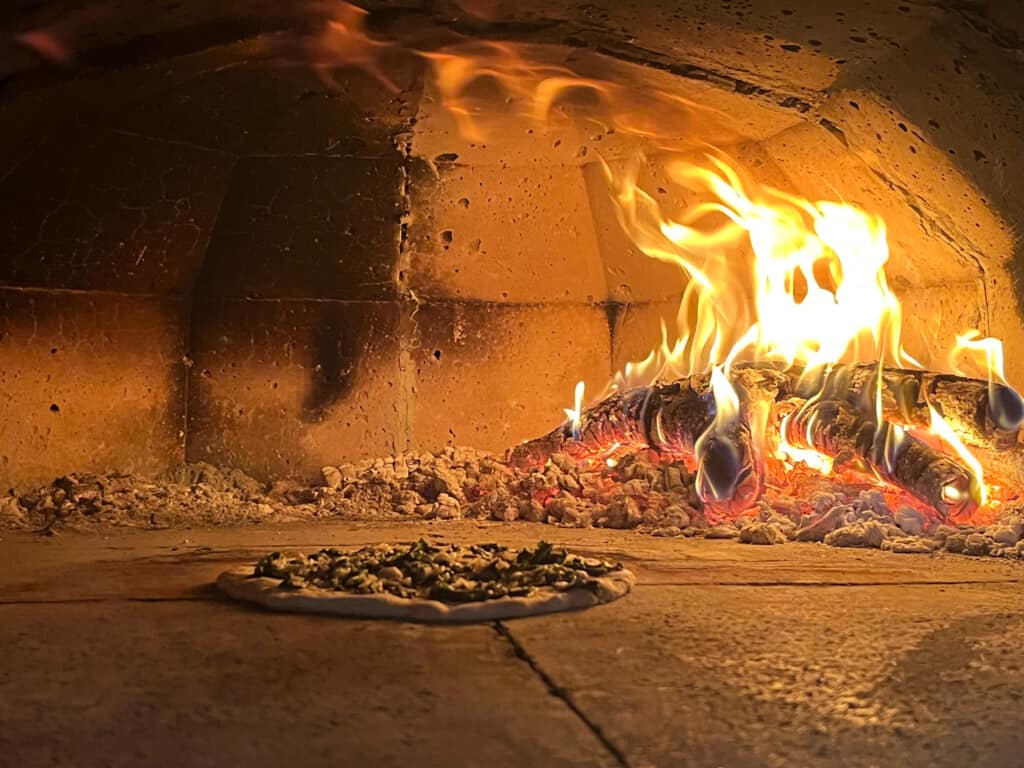Last updated on April 4th, 2024
Have you ever wondered how Ligurian focaccia is different from regular focaccia?
Do you dream of the bread pillows you chowed down on during your last trip to the Cinque Terre?
If you’re looking for a full-proof recipe to recreate authentic ligurian focaccia at home then you’ve come to the right place!
In this article, I will walk you through what exactly authentic Ligurian focaccia is, how it’s different from regular focaccia and guide you through my authentic Ligurian focaccia recipe full of tips and tricks to ensure it comes out perfectly every time!
Jump to Section
How to Pronounce Focaccia
Focaccia in Italian is pronounced foh-kahch-chyah.
Listen to the pronunciation of focaccia:
What Is Ligurian Focaccia?

Ligurian focaccia is a leavened Italian flatbread from the northwestern region of Liguria that’s:
- baked in either regular ovens or brick ovens
- baked in oil coated pans
- coated with a salt brine
In the local dialect, it’s also known as fugassa (pronounced foo-gahs-sah in Italian) but you might also hear it called focaccia ligure or focaccia genovese.
How Is Ligurian Focaccia Different From Regular Focaccia?
There are several factors that set authentic Ligurian focaccia from regular focaccia. The main difference is the salty brine that is poured over the bread just before the final rise in the pan, creating an extra salty, crunchy crust. The brine settles into the dimples imprinted onto the Ligurian focaccia, creating an extra flavorful dough. The brine also helps to keep the inside moist and spongy, giving it an extra soft and fluffy interior.
Other kinds of focaccia are still crunchy on the outside but they may be thinner and more chewy as opposed to soft and pillowy. Ligurian focaccia tends to be a bit thicker or ‘taller’ as they define it in Italian.
Another defining characteristic of authentic Ligurian focaccia is the olive oil used in the dough. Liguria is known to produce some of the very best olive oil in all of Italy. Their version, made from the taggiasca olive, is very delicate and mild.
Ingredients For Authentic Ligurian Focaccia

For the dough:
- 1.5 cups + 2 tablespoons (200 grams) baking flour
- 3.5 cups (300 grams) bread flour
- 1 teaspoon active dry yeast
- 350 ml water
- 1 teaspoon salt
- 3 tablespoons olive oil + 4 tablespoons for baking
- 2 teaspoons honey
- flakey sea salt
For the brine:
- ¾ teaspoon sea salt
- ⅓ cup (75 ml) lukewarm water
Water
You can absolutely use tap water but be sure it’s lukewarm. This means it should not feel hot like bath water but it should not be cold either. This is important for activating the yeast.
Honey
Honey is important because it not only helps to give the ligurian focaccia its deep, golden, color, but it helps with the fermentation process of the dough.
Flour

For Ligurian focaccia, I find it best to use a mix of baking flour and all-purpose flour. The baking flour has a higher protein content, making a more stable and elastic dough while the all-purpose is a good, everyday workhorse.
To learn more about flour, read Guide to Italian Flour – Straight from Italy
Salt
Here in Italy we use regular table salt for most things. Kosher salt isn’t very common. Use kosher if you prefer to note that it has less sodium by volume.
For a finishing salt, a flakey sea salt is best such as Maldon.
Extra Virgin Olive Oil
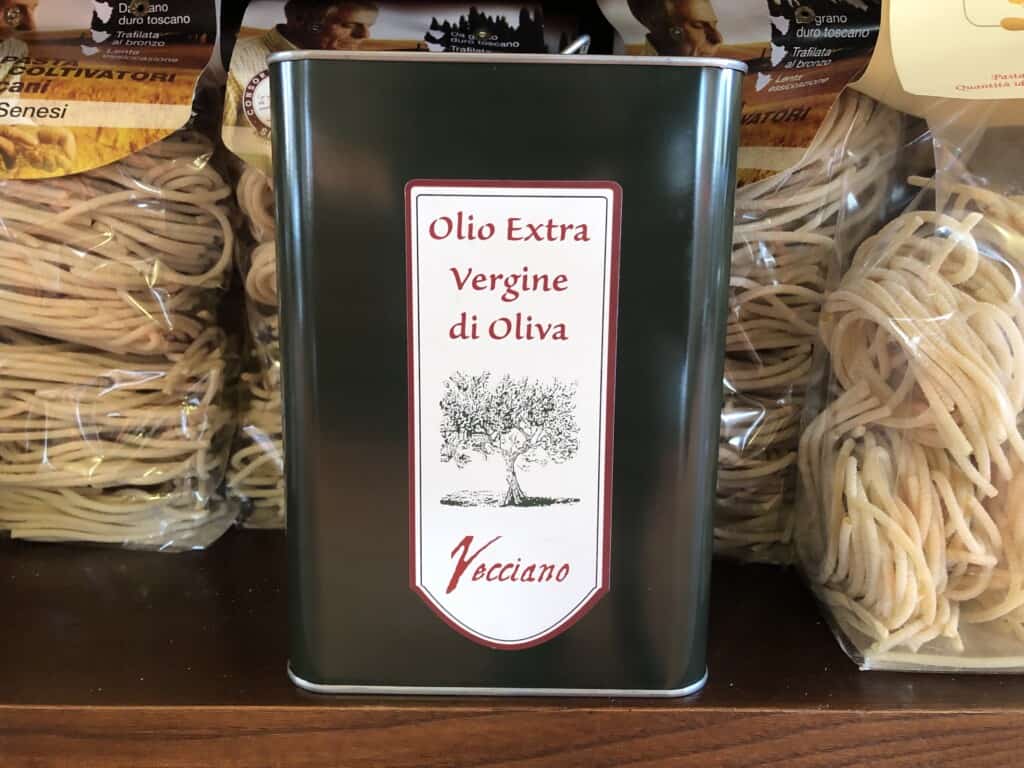
Use whatever extra virgin olive oil is affordable and convenient for you. Of course, the better quality you use, the more the flavor will come through in your dough. This being said, you can absolutely substitute with regular olive oil if you don’t have extra virgin.
For our suggestions and guide to buying olive oils read 15 Best Italian Olive Oils – To Enjoy in Italy & Bring Home as a Souvenir and Best Italian Olive Oil Brands in America – Where to Buy Them and How to Store Them.
How To Make Ligurian Focaccia
With a stand mixer fitted with the dough hook, dissolve the yeast in the water. Mix well and add the two flours.
Add the salt and olive oil and honey and continue to mix until well incorporated. Mix on medium speed for two or three minutes until the dough is smooth.

Transfer the dough to a large lightly oiled bowl, cover with plastic wrap and for two hours until doubled in size, performing a series of four folds every 30 minutes by lifting up one corner of the dough with a wet hand, pulling it up and bringing it back down on top of the dough on the opposite side. Turn the bowl a quarter of a turn and repeat 3 more times until all the dough has been folded upon itself (2 hours total).
Watch how I fold the dough in this short video:
Finish proofing at room temperature, anywhere from 1-4 hours more, depending on the weather, humidity, time of year, etc., or until doubled in size.

Oil a 15×10.5 pan well with 1 tablespoon olive oil, being sure the sides are well oiled as well. Turn the dough out onto the oiled baking sheet.

Using slightly wet or oiled hands, pull and stretch the dough out into an even rectangle, pulling from the underside of the dough outward, being sure it reaches to the edges of the pan. The dough will spring back, so repeat stretching once or twice over the next 30 minutes to ensure the dough remains stretched out fully to the edges.
Brush with another 1-2 tablespoons of olive oil, cover with plastic wrap and let rise for about 1 hour while the oven is preheating to 475° F (245° C) until puffed.
How To Dimple Ligurian Focaccia

The trick to dimpling ligurian focaccia is to keep your fingers moist. Dip your fingertips in water frequently. You also want to use the whole pads of your fingers to dimple the ligurian focaccia, not just the tips. If you just use your fingertips, you risk piercing the dough and creating smaller dimples. You ideally want to achieve large, wide dimples that will hold the brine well.

Mix the brine and pour evening over the dough so it fills all the dimples.
Sprinkle the Ligurian focaccia lightly with flaky salt and bake on the lower rack of the oven for 13-18 minutes until golden and crisp.
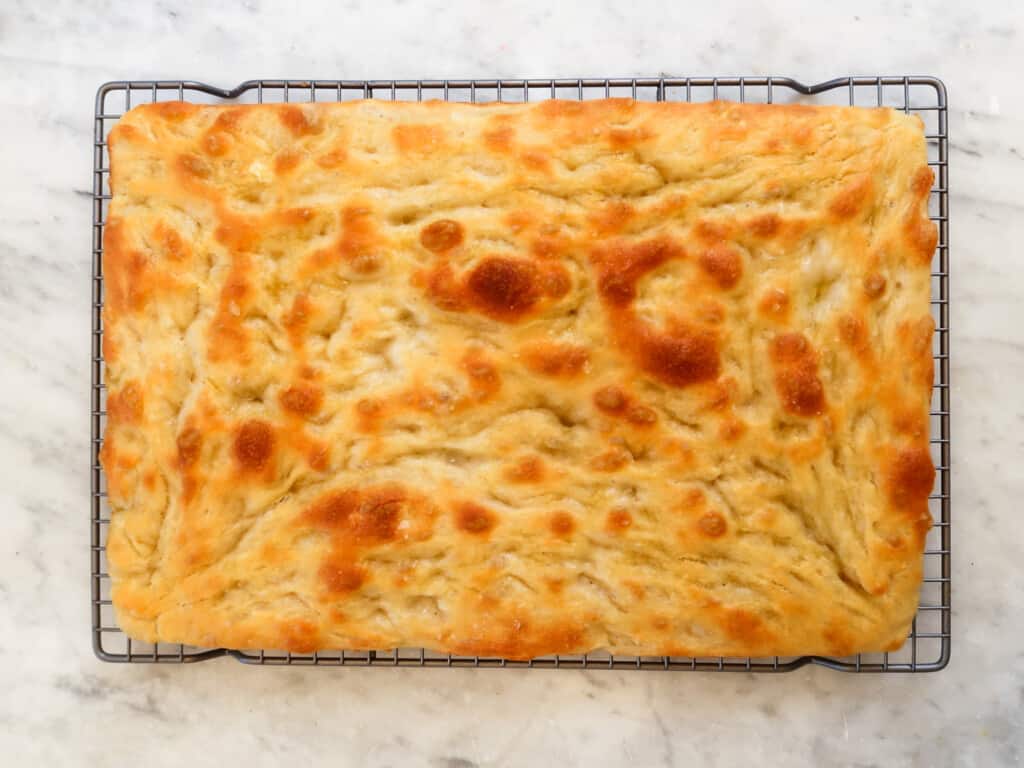
Remove and brush with another tablespoon of extra virgin olive oil. Let cool for 5 minutes in the pan and then transfer to a wire rack to finish cooling completely. You may need to use a knife to loosen it from the edges.
Substitutions For Authentic Ligurian Focaccia

Although authentic ligurian focaccia is defined by the delicate, bright flavor of local extra virgin olive oil, you can certainly use olive oil if that is all you have.
Feel free to also play with the type of flour. I always like to keep a portion of baking flour while I swap out the all-purpose (or a portion of) for other flours such as whole wheat.
Although not traditional, you can certainly add dried herbs or other simple ingredients such as halved cherry tomatoes or olives to the top right before adding the brine.
How To Serve Authentic Ligurian Focaccia

Authentic Ligurian focaccia is enjoyed throughout the day in Liguria and all of Italy. In Liguria, this is the local bread and thus, it’s found on every dinner table. When enjoyed at a meal, it’s an accompaniment to appetizers and second courses.
Popular ways Italians enjoy Ligurian focaccia:
Fun Fact: Focaccia in Italy is meant to be eaten capovolta or turned upside down, meaning the salty, oily part should hit your tongue first so you can experience the full explosion of flavor!
More Veg Please: Check out my list of Vegetarian Dishes to Try in Italy.
Ligurian Focaccia – Notes and Tips

- Try and have the dough reach the edges of the pan to ensure the brine doesn’t end up under the focaccia. It should stay on top.
- Don’t skimp on the olive oil because that is one of the authentic ligurian focaccia’s defining factors.
- The ease of stretching your dough will vary greatly depending on the climate, humidity, time of year, and type/brand of flour. Be patient and use the times as guidelines, not rules.
- The proofing/rising time will also depend on these facts – be sure to proof properly and don’t rush it. When it’s cold, rising times will be much longer than in the summer!
- Use an oven thermometer to ensure your oven is at the correct temperature.

Authentic Ligurian Focaccia
Ingredients
- 1.5 cups + 2 Tbsp baking flour (200 g)
- 3.5 cups bread flour (300 g)
- 1 tsp active dry yeast
- 350 ml water
- 1 tsp salt
- 3 Tbsp olive oil + more for baking
- 2 tsp honey
- flakey sea salt
- 3/4 tsp sea salt (for the brine)
- 1/3 cup lukewarm water (75 ml, for the brine)
Instructions
- With a stand mixer fitted with the dough hook, dissolve the yeast in the water. Mix well and add the two flours.
- Add the salt and olive oil and honey and continue to mix until well incorporated. Mix on medium speed for two or three minutes until the dough is smooth.
- Transfer the dough to a large lightly oiled bowl, cover with plastic wrap and for two hours until doubled in size, performing a series of four folds every 30 minutes by lifting up one corner of the dough with a wet hand, pulling it up and bringing it back down on top of the dough on the opposite side. Turn the bowl a quarter of a turn and repeat 3 more times until all the dough has been folded upon itself (2 hours total). Finish proofing at room temperature, anywhere from 1-4 hours more, depending on the weather, humidity, time of year, etc., or until doubled in size.
- Oil a pan well with 1 tablespoon olive oil and turn the dough out onto the oiled baking sheet.
- Using slightly wet or oiled hands, pull and stretch the dough out into an even rectangle (or whatever shape you can manage; it can be a little challenging to spread out), pulling from the underside of the dough outward, being sure it reaches to the edges of the pan. The dough will spring back, so repeat stretching once or twice over the next 30 minutes to ensure the dough remains stretched out fully to the edges.
- Brush with another 1-2 tablespoons of olive oil, cover with plastic wrap and let rise for about 1 hour while the oven is preheating to 475° F (245° C) until puffed.
- Dimple the ligurian focaccia. The trick is to keep your fingers moist. Dip your fingertips in water frequently. You also want to use the whole pads of your fingers to dimple the ligurian focaccia, not just the tips. If you just use your fingertips, you risk piercing the dough and creating smaller dimples. You ideally want to achieve large, wide dimples that will hold the brine well.
- Mix the brine and pour evening over the dough so it fills all the dimples.
- Sprinkle the ligurian focaccia lightly with flaky salt and bake on the lower rack of the oven for 13-18 minutes until golden and crisp.
- Remove and brush with another tablespoon of extra virgin olive oil. Let cool for 5 minutes in the pan and then transfer to a wire rack to finish cooling completely. You may need to use a knife to loosen it from the edges.
Notes
- Try and have the dough reach the edges of the pan to ensure the brine doesn’t end up under the focaccia. It should stay on top.
- Don’t skimp on the olive oil because that is one of the authentic ligurian focaccia’s defining factors.
- The ease of stretching your dough will vary greatly depending on the climate, humidity, time of year, and type/brand of flour. Be patient and use the times as guidelines, not rules.
- The proofing/rising time will also depend on these facts – be sure to proof properly and don’t rush it. When it’s cold, rising times will be much longer than in the summer!
- Use an oven thermometer to ensure your oven is at the correct temperature.
Authentic Ligurian Focaccia Recipe FAQ
You can store this Ligurian focaccia in an airtight container for one day, however, it’s really best the day it’s made.
You can also freeze individual pieces by wrapping them well in plastic wrap and then in a zip lock bag. When freezing focaccia, it does loose any crispy bits on the surface.
You can easily reheat focaccia by toasting it lightly in a toaster oven or putting it in a 300°F preheated oven until warmed through. You should never reheat bread or focaccia in the microwave.
The brine creates a crunchy, golden exterior while keeping the inside moist and fluffy.
